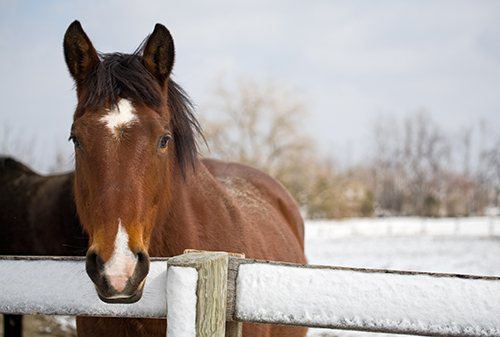A Guide to Winter Hoof Care
Jan 15, 2024

It’s International Hoof Care Week, a time dedicated to recognizing the importance of proper hoof care for the well-being of our horses. The upkeep of horses is already a challenging task in many cases, and snow, ice, and mud can escalate the situation even more. Proper hoof care is therefore essential during this season to keep your equine companions happy and healthy in the colder months.
In this blog, we’ll explore some valuable tips and practices to help you keep your horse’s hooves in top condition throughout the winter.
Regular inspection
Begin your hoof care routine with regular inspections. Even if you’re not riding, check your horse’s hooves daily for any signs of damage, cracks, or abnormalities. Snow and ice can quickly accumulate in the hooves, potentially leading to discomfort and injury. Use a hoof pick to gently remove any packed snow or ice and ensure your horse can move comfortably.
Proper trimming
Regular farrier visits remain crucial in the winter, just as they do in other seasons. However, be careful not to trim the hooves too short during the colder months, as this may leave your horse even more vulnerable to the harsh elements. A good farrier will aim for a balanced and appropriate hoof length that provides adequate protection against the cold without compromising your horse’s movement.
Protection against wet conditions
Winter often brings wet and muddy conditions, which can soften horses’ hooves and make them more susceptible to infections. To mitigate this risk, consider applying a hoof sealant or dressing to create a protective barrier against moisture. This will help maintain the integrity of the hooves and prevent issues like thrush.
Dry bedding
Ensure your horse’s stall stays bedded with dry, clean shavings. This is particularly important during the winter when the ground is wet and muddy. A dry environment helps prevent horses’ hooves from becoming soft and promotes overall hoof health.
Adequate nutrition
Proper nutrition is the cornerstone of hoof health. During winter, when cold weather and reduced pasture availability can impact your horse’s diet, consider supplementing with a high-quality hoof supplement. This can provide essential nutrients like biotin, zinc, and methionine, supporting healthy hoof growth.
Regular exercise
Maintain regular exercise for your horse, even if this just involves lunging them for a few minutes when it’s too cold to ride. Exercise promotes healthy blood circulation, which is essential for maintaining strong and resilient hooves. Additionally, movement helps prevent stiffness in horses’ legs and can contribute to their overall health.
Caring for your horse’s hooves in the winter requires attention to detail and a proactive approach. By incorporating these tips into your winter horse care routine, you can ensure your horse’s hooves remain healthy, resilient, and ready to face the challenges of the colder months. Remember, a little extra care during the winter can go a long way in preserving the well-being of your beloved horse.
Your local Co-op has a selection of equine supplies and feed for your farm. Don’t hesitate to reach out with any questions about the items that we have in stock. Find the nearest location here.
For more content like this, check out the latest issue of The Cooperator.
In this blog, we’ll explore some valuable tips and practices to help you keep your horse’s hooves in top condition throughout the winter.
Regular inspection
Begin your hoof care routine with regular inspections. Even if you’re not riding, check your horse’s hooves daily for any signs of damage, cracks, or abnormalities. Snow and ice can quickly accumulate in the hooves, potentially leading to discomfort and injury. Use a hoof pick to gently remove any packed snow or ice and ensure your horse can move comfortably.
Proper trimming
Regular farrier visits remain crucial in the winter, just as they do in other seasons. However, be careful not to trim the hooves too short during the colder months, as this may leave your horse even more vulnerable to the harsh elements. A good farrier will aim for a balanced and appropriate hoof length that provides adequate protection against the cold without compromising your horse’s movement.
Protection against wet conditions
Winter often brings wet and muddy conditions, which can soften horses’ hooves and make them more susceptible to infections. To mitigate this risk, consider applying a hoof sealant or dressing to create a protective barrier against moisture. This will help maintain the integrity of the hooves and prevent issues like thrush.
Dry bedding
Ensure your horse’s stall stays bedded with dry, clean shavings. This is particularly important during the winter when the ground is wet and muddy. A dry environment helps prevent horses’ hooves from becoming soft and promotes overall hoof health.
Adequate nutrition
Proper nutrition is the cornerstone of hoof health. During winter, when cold weather and reduced pasture availability can impact your horse’s diet, consider supplementing with a high-quality hoof supplement. This can provide essential nutrients like biotin, zinc, and methionine, supporting healthy hoof growth.
Regular exercise
Maintain regular exercise for your horse, even if this just involves lunging them for a few minutes when it’s too cold to ride. Exercise promotes healthy blood circulation, which is essential for maintaining strong and resilient hooves. Additionally, movement helps prevent stiffness in horses’ legs and can contribute to their overall health.
Caring for your horse’s hooves in the winter requires attention to detail and a proactive approach. By incorporating these tips into your winter horse care routine, you can ensure your horse’s hooves remain healthy, resilient, and ready to face the challenges of the colder months. Remember, a little extra care during the winter can go a long way in preserving the well-being of your beloved horse.
Your local Co-op has a selection of equine supplies and feed for your farm. Don’t hesitate to reach out with any questions about the items that we have in stock. Find the nearest location here.
For more content like this, check out the latest issue of The Cooperator.